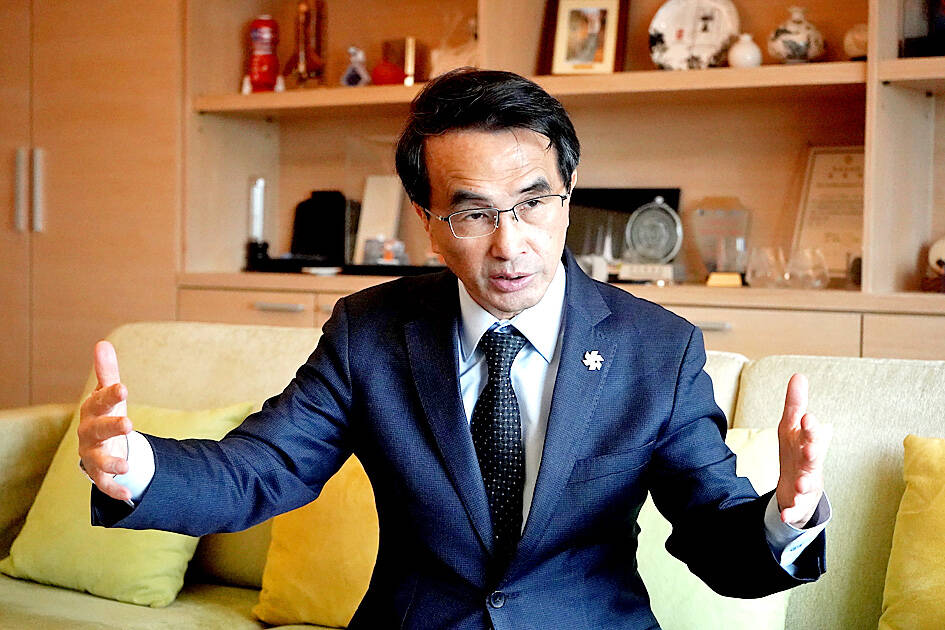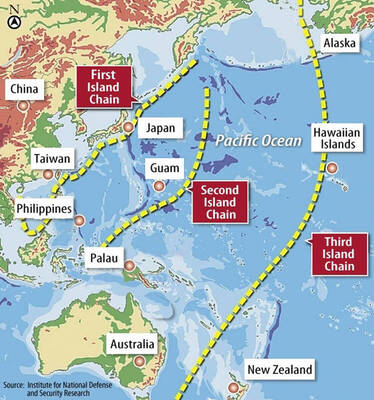The Taiwan Space Agency (TASA) yesterday said it plans to launch six low Earth orbit satellites starting in 2026 as part of the government’s plan to boost the resilience of the nation’s communications.
The development of the technology gained attention after Ukrainians were able to access the Internet through Space Exploration Technologies Corp (SpaceX) CEO Elon Musk’s Starlink satellite service, despite their infrastructure being severely damaged in the war with Russia.
Two of the satellites would be built by the government, while four would involve cooperation between TASA and private contractors.

Photo courtesy of the Industrial Technology Research Institute
“Over the past 30 years, the satellite technology in Taiwan has mostly been used for remote sensing and meteorological observations,” National Science and Technology Council Minister Wu Tsung-tsong (吳政忠) said.
“The research and development of communications satellite technology is indeed challenging, as it is complicated and fast-changing. As such, the government needs to take the lead, which is why it has extended the Phase III space project to 2031 and added NT$40 billion [US$1.23 billion] to the budget,” he said.
TASA Director-General Wu Jong-shinn (吳宗信) said the agency plans to launch the first low Earth orbit satellite in 2026 using a SpaceX rocket and the second one in 2028.

Photo: CNA
The first satellite’s body would be made in Taiwan, but the Ka bend communication payload would be built in partnership with an overseas contractor, he said.
The second satellite would be jointly developed by the Industrial Technology Research Institute, which is capable of developing 4G and 5G systems, and TASA, Wu Jong-shinn said.
The total budget to launched the two rockets is NT$900 million, he said, adding that the agency hopes that the contracts for the four other satellites will be placed on auction this year.
Aside from Starlink, there are other low Earth orbit satellite service providers, many of whom are eager to set up ground stations in Taiwan.
“However, we have to try to develop the technology ourselves. That way, we would not be worried if some companies refuse to transfer it to us,” Wu Jong-shinn said.
The launch of the six low Earth orbit satellites, known as project “Beyond 5G (B5G),” would only be the beginning, Wu Tsung-tsong said.
Simulations have shown that if there are two low-orbit communication satellites, they would only hover over Taiwan for three to five minutes when orbiting the Earth, he said.
“To achieve uninterrupted communication 24 hours a day, it is obvious that six satellites would not be enough. Taiwan needs at least 120 satellites to build communications resilience,” he said.
The next step is to build up the satellite communications industry, which not only includes existing electronics industry operators, but also new entrepreneurs, Wu Tsung-tsong said.
“They will see that telecommunications business opportunities in the next 10 or 20 years will be in space,” he said.
“Taiwan’s space ground equipment industry is already of considerable scale, with an output value exceeding NT$200 billion, but there is still a lot of room for growth in satellite manufacturing, rocket launch services and other fields,” he said. “Like a baseball player who can pitch and hit, Taiwan must be skilled on the ground and in space.”

The US government has signed defense cooperation agreements with Japan and the Philippines to boost the deterrence capabilities of countries in the first island chain, a report by the National Security Bureau (NSB) showed. The main countries on the first island chain include the two nations and Taiwan. The bureau is to present the report at a meeting of the legislature’s Foreign Affairs and National Defense Committee tomorrow. The US military has deployed Typhon missile systems to Japan’s Yamaguchi Prefecture and Zambales province in the Philippines during their joint military exercises. It has also installed NMESIS anti-ship systems in Japan’s Okinawa

‘WIN-WIN’: The Philippines, and central and eastern European countries are important potential drone cooperation partners, Minister of Foreign Affairs Lin Chia-lung said Minister of Foreign Affairs Lin Chia-lung (林佳龍) in an interview published yesterday confirmed that there are joint ventures between Taiwan and Poland in the drone industry. Lin made the remark in an exclusive interview with the Chinese-language Liberty Times (the Taipei Times’ sister paper). The government-backed Taiwan Excellence Drone International Business Opportunities Alliance and the Polish Chamber of Unmanned Systems on Wednesday last week signed a memorandum of understanding in Poland to develop a “non-China” supply chain for drones and work together on key technologies. Asked if Taiwan prioritized Poland among central and eastern European countries in drone collaboration, Lin

BACK TO WORK? Prosecutors said they are considering filing an appeal, while the Hsinchu City Government said it has applied for Ann Kao’s reinstatement as mayor The High Court yesterday found suspended Hsinchu mayor Ann Kao (高虹安) not guilty of embezzling assistant fees, reducing her sentence to six months in prison commutable to a fine from seven years and four months. The verdict acquitted Kao of the corruption charge, but found her guilty of causing a public official to commit document forgery. The High Prosecutors’ Office said it is reviewing the ruling and considering whether to file an appeal. The Taipei District Court in July last year sentenced Kao to seven years and four months in prison, along with a four-year deprivation of civil rights, for contravening the Anti-Corruption

NO CONFIDENCE MOTION? The premier said that being toppled by the legislature for defending the Constitution would be a democratic badge of honor for him Premier Cho Jung-tai (卓榮泰) yesterday announced that the Cabinet would not countersign the amendments to the local revenue-sharing law passed by the Legislative Yuan last month. Cho said the decision not to countersign the amendments to the Act Governing the Allocation of Government Revenues and Expenditures (財政收支劃分法) was made in accordance with the Constitution. “The decision aims to safeguard our Constitution,” he said. The Constitution stipulates the president shall, in accordance with law, promulgate laws and issue mandates with the countersignature of the head of the Executive Yuan, or with the countersignatures of both the head of the Executive Yuan and ministers or